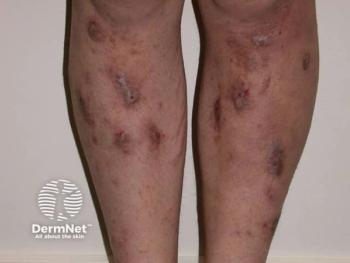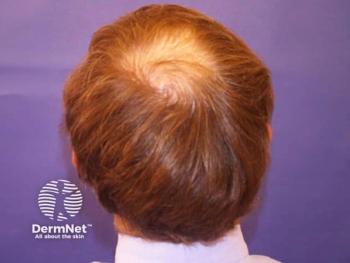
Weight-based dosing: Extended-release minocycline efficient, predictable
Las Vegas - Weight-based dosing with extended-release (ER) minocycline tablets allows patients with acne to achieve efficacy equivalent to that of 2 mg/kg or 3 mg/kg of body weight daily with just 1 mg/kg daily, says James Q. Del Rosso, D.O., dermatology residency director, Valley Hospital Medical Center, Las Vegas.
Las Vegas - Weight-based dosing with extended-release (ER) minocycline tablets allows patients with acne to achieve efficacy equivalent to that of 2 mg/kg or 3 mg/kg of body weight daily with just 1 mg/kg daily, says James Q. Del Rosso, D.O., dermatology residency director, Valley Hospital Medical Center, Las Vegas.
Minocycline ER, furthermore, has been shown to reduce the risk of vestibular side effects and provides a more predictable pharmacokinetic profile than does immediate release (IR) minocycline, he says.
"When one is treating acne vulgaris with oral antibiotics, more is not necessarily better in terms of efficacy," Dr. Del Rosso tells Dermatology Times.
With minocycline ER - the first oral antibiotic approved by the Food and Drug Administration (FDA) for treating acne vulgaris - weight-based dosing allows physicians to reduce peak serum levels and cumulative exposure, which correlate with a lower risk of certain adverse events, such as vestibular side effects and possibly hyperpigmentation, he says.
Adverse events
Regarding adverse events, a blinded crossover study of 32 female subjects showed that generic minocycline IR formulations which release 100 percent of the drug over 15 minutes produced a fivefold greater risk of vestibular side effects compared to a branded minocycline IR product that released 90 percent of the drug over 45 minutes (p = 0.0003; Del Rosso JQ. Cutis. 2006;77:153-156).
An additional pharmacokinetic evaluation showed that minocycline ER tablets produce slower, more prolonged drug release (up to 85 percent in four hours), with weight-based studies showing that minocycline ER carries a lower risk of vestibular side effects, Dr. Del Rosso says.
Moreover, the incidence of acute vestibular adverse events (AVAEs) with minocycline ER appears to be dose-related, according to a phase 2 double-blinded, randomized 12-week trial (Data on file: NDA 58-808; Section 2.7.4.7; Table 5.1. Medicis 2006.)
In this trial, fewer AVAEs occurred in the 1 mg/kg/day cohort than in the placebo cohort, Dr. Del Rosso says.
Based on combined data from phase 2 and 3 clinical trials, he adds, "The risk of vestibular side effects with minocycline ER 1 mg/kg per day appears to be comparable to that of placebo."
Lesion counts
As for inflammatory lesion counts, a phase 2 dose-ranging study that evaluated the efficacy of once-daily minocycline ER tablets in subjects with moderate-to-severe acne vulgaris showed that 1 mg/kg/day performed as effectively as 2 mg/kg/day or 3 mg/kg/day (Stewart DM, Torok HM, Weiss JS et al. Cutis. 2006;78(Suppl 4):11-20).
In this study, the 1 mg/kg dose achieved a mean 56.8 percent reduction in inflammatory lesion counts, versus 49.3 percent and 46.6 percent for 2 mg/kg and 3 mg/kg, respectively.
Regarding drug absorption, Dr. Del Rosso says, "The pharmacokinetic data collected with minocycline ER tablets represents dermatologists' first attempt to establish a dose-response correlation with efficacy and safety - and to assess potential variability in drug absorption among patients - with an oral antibiotic used to treat acne vulgaris."
In particular, a randomized, active-controlled crossover study involving 30 patients allowed researchers to compare steady-state systemic exposure between minocycline ER tablets and minocycline IR capsules.
Variability
In this study, minocycline ER showed less variability in peak plasma concentration (Cmax) than minocycline IR, as well as less variability in area under the curve (AUC), an indicator of systemic exposure to minocycline over time, Dr. Del Rosso says.
"Lower bioavailability of minocycline may occur in some patients who lie at the low end of the absorption curve. This could result in a diminished response to treatment in a subset of patients," he says.
However, Dr. Del Rosso says most subjects treated with minocycline ER show a narrow range of variability in peak serum concentration and systemic exposure over time, allowing for better predictability of overall response when taking into account both efficacy and safety.
Conversely, he says minocycline IR delivers a broader range in peak serum concentration and systemic exposure over time, and a less predictable pharmacokinetic profile.
Therefore, Dr. Del Rosso says that with the IR formulation, "High absorbers would have greater potential to experience adverse events - especially vestibular side effects."
Accordingly, he says that when clinicians encounter a lack of efficacy or troublesome side effect, "Consider variation in absorption as a possible reason. In these cases, one may need to change dosing because a subset of patients may be either ’low end’ or ’ high end’ GI absorption outliers." DT
Disclosures: Dr. Del Rosso is a researcher, consultant and/or speaker for Allergan, Coria, Galderma, Graceway, Intendis, Medicis, Onset Therapeutics, OrthoNeutrogena, Pharmaderm, Quinnova, Ranbaxy, SkinMedica, Stiefel, Unilever and Warner Chilcott.
Newsletter
Like what you’re reading? Subscribe to Dermatology Times for weekly updates on therapies, innovations, and real-world practice tips.


















